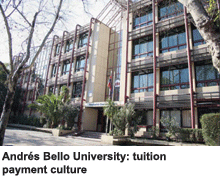In sharp contrast to many of its Latin American neighbours, Chile (pop. 17.2 million) has one of the most market-driven and privately funded higher education systems in the world. It has also seen a tenfold increase in student enrolment since the early 1980s.
Before that, the country’s two public universities — the University of Chile and the State Technical University (now the University of Santiago) — and a small number of private (mostly Roman Catholic) institutions received public subsidies of up to 90 percent of their income.
But funding declined in the decade following the 1973 coup d’état in which the democratically elected government of Salvador Allende was overthrown by military leader Augusto Pinochet. Universities responded to the decline in state funding by gradually raising tuition fees and cutting student numbers from 150,000 to about 100,000.
 According to Andrés Bernasconi Ramírez, academic vice-rector of Andrés Bello University, one of Chile’s largest private institutions, the military junta’s higher education policy had two main drivers. One was the neo-liberal belief that it was “healthy for institutions to diversify their funding base and to make students pay for the private returns they got from their investment in higher education”. The other was Gen. Pinochet’s perception of universities — especially giant public ones — as wellsprings of dissent against his regime. But the military dictatorship also valued education as a source of economic growth. While Pinochet’s 1981 higher education reforms were intended to address the perceived political threat posed by the public universities by giving autonomy to their regional campuses, they also introduced a generous system of “solidarity loans” at 2 percent to cover students’ tuition fees.
According to Andrés Bernasconi Ramírez, academic vice-rector of Andrés Bello University, one of Chile’s largest private institutions, the military junta’s higher education policy had two main drivers. One was the neo-liberal belief that it was “healthy for institutions to diversify their funding base and to make students pay for the private returns they got from their investment in higher education”. The other was Gen. Pinochet’s perception of universities — especially giant public ones — as wellsprings of dissent against his regime. But the military dictatorship also valued education as a source of economic growth. While Pinochet’s 1981 higher education reforms were intended to address the perceived political threat posed by the public universities by giving autonomy to their regional campuses, they also introduced a generous system of “solidarity loans” at 2 percent to cover students’ tuition fees.
Despite the fact that no state funding was offered, Prof. Bernasconi noted 38 private institutions were subsequently founded, taking the current number of universities in Chile to 63. The return of democracy in 1990 did not lead to public funding flowing back into public universities. Only 11 percent of their income currently comes from block grants.
“The total funding for higher education from the Chilean government is about £1 billion (Rs.7,300 crore) a year, which is the budget of a mid-sized university in Brazil. The (post-1990) democratic government realised it had such a huge problem with primary and secondary education that higher education was never a funding priority,” says Prof. Bernasconi.
Hence, tuition fees in Chile remain among the highest in the world when adjusted for its per capita gross domestic product, which stands at about £9,000 (Rs.6.57 lakh). Fees vary according to the course and the prestige of the institution, but start at about £2,000 (Rs.1.46 lakh) per year at a public regional university; about £5,000 (Rs.3.65 lakh) at the University of Chile (now based entirely in Santiago, with fewer than 30,000 students); and up to £6,000 (Rs.4.38 lakh) at leading private universities.
Despite this, there is little student opposition to current fees. “Paying back loans is part of the culture already,” says Bernasconi. “It was probably a shock in the first decade, but fees did not rise immediately to their current levels. Little by little, they have been increasing by more than inflation.”
(Excerpted and adapted from Times Higher Education)